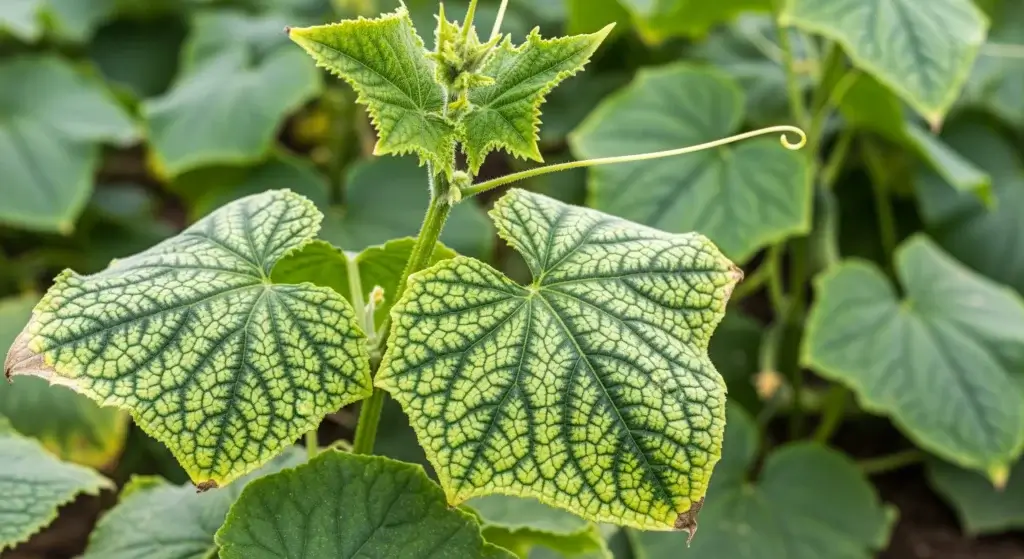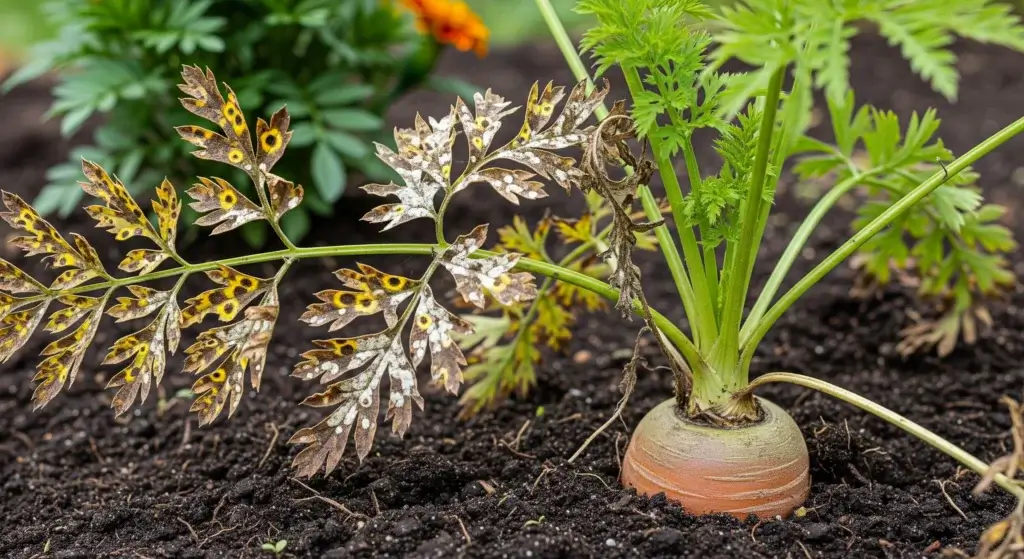
Growing zucchini in your garden can be incredibly rewarding due to its high yield and versatile culinary uses.
However, zucchini plants can fall victim to various diseases, one of the most common being powdery mildew.
This fungal disease can severely impact the health and productivity of your plants if not managed properly.
In this blog post, we’ll dive deep into the causes, symptoms, prevention strategies, and organic treatments for powdery mildew on zucchini to help you keep your garden healthy and productive.
Causes of Powdery Mildew
Powdery mildew is a widespread fungal disease that affects a variety of plants, including zucchini.
It is caused by different species of fungi within the Erysiphales family.
Here are the primary factors that contribute to the development and spread of powdery mildew:
- Read also: Powdery Mildew on Cucumber Plants: Solutions and Prevention
- Read also: Conquer the Curse: Strategies for Powdery Mildew on Pumpkins
Fungal disease
Powdery mildew is a common fungal disease caused by different types of fungi from the Erysiphales family.
These fungi thrive in specific conditions and can easily spread from one plant to another.
Warm and humid conditions
Powdery mildew likes warm and humid weather.
Temperatures between 60-80°F (15-27°C) are perfect for its growth.
High humidity levels provide the moisture that fungal spores need to start growing and infect plants.
Poor air circulation
Plants that don’t get enough air movement around them are more likely to get powdery mildew.
When plants are too close together or have dense foliage, it creates a small space where humidity can build up.
This makes it easier for fungal spores to settle and cause infection.
Water splash-back
Water splashing onto plants from rain or overhead watering can carry fungal spores from infected soil or plants to healthy ones nearby.
That’s why it’s important to water plants at the base and avoid wetting their leaves too much.
Managing watering carefully helps reduce the risk of spreading powdery mildew in your garden.
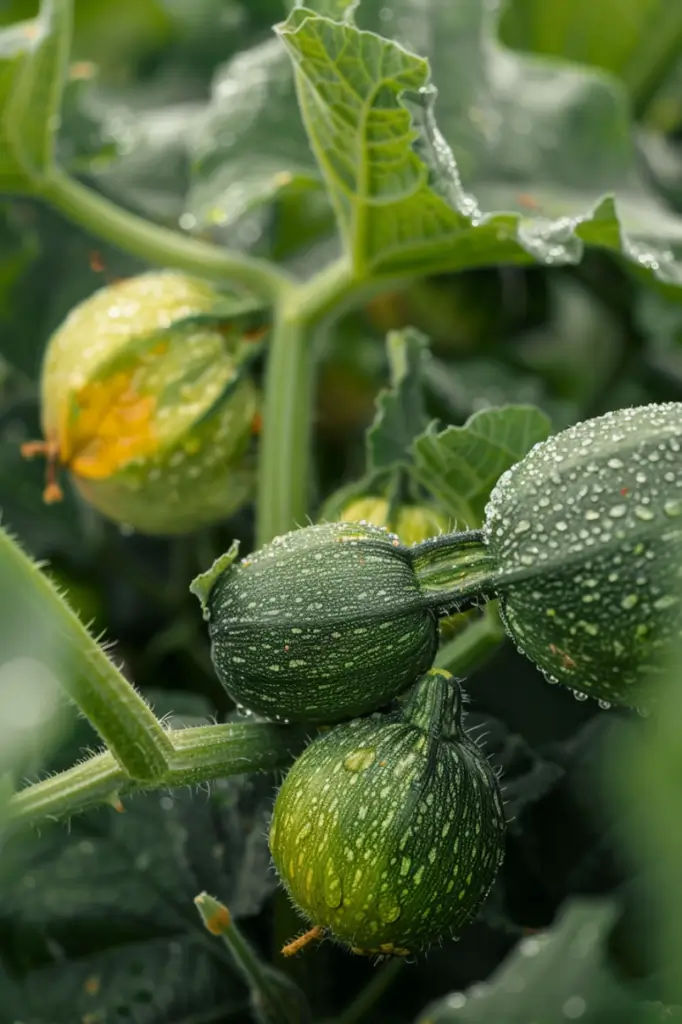
Symptoms of Powdery Mildew
Recognizing the symptoms of powdery mildew early can help you take action before the disease severely impacts your zucchini plants.
Here are the key symptoms to look out for:
White coating
One of the easiest ways to spot powdery mildew is by its appearance—a powdery white or grayish coating on the leaves, stems, and sometimes the fruit of your zucchini plants.
This coating can look like someone sprinkled powder on your plants.
You can gently wipe it off, but it usually comes back quickly if the infection isn’t treated.
Discolored leaves
As powdery mildew takes hold, the affected leaves may start to change color.
They might turn yellow, brown, or even curl up and eventually die.
This happens because the fungus is feeding on the plant, taking away important nutrients.
Reduced photosynthesis
The white coating on the leaves can block sunlight from reaching the plant cells that do photosynthesis—the process that helps plants make food and grow.
When this happens, the plant can’t make enough food for itself, which weakens it and slows down its growth.
This can lead to smaller harvests of zucchinis.
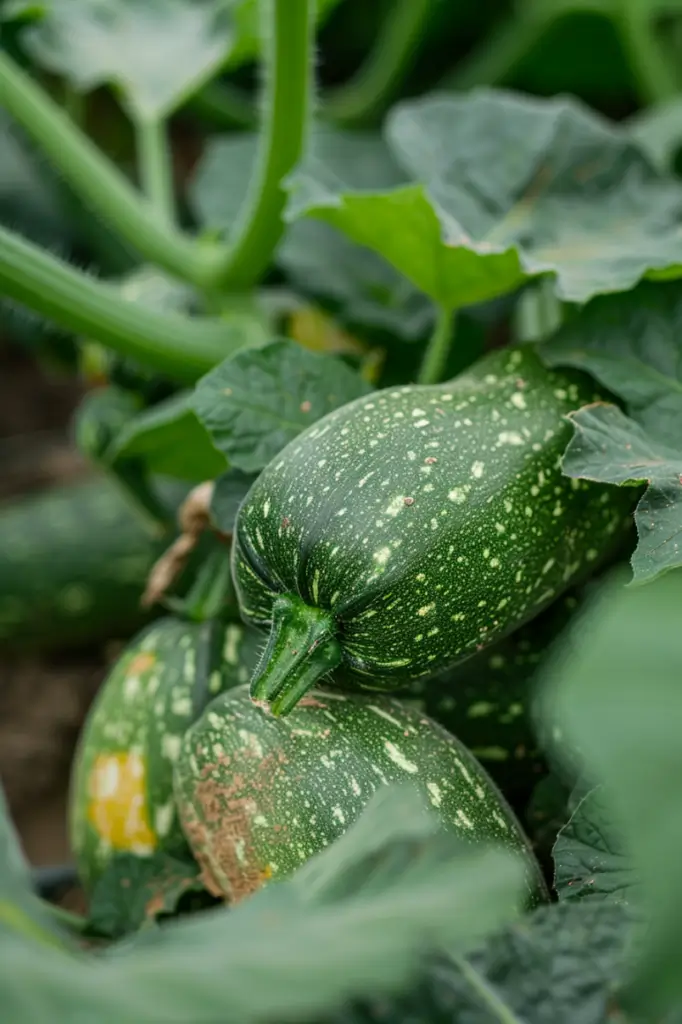
Prevention Strategies
Preventing powdery mildew is much easier than treating it once it has taken hold.
Here are some effective strategies to keep your zucchini plants healthy and free from powdery mildew:
Plant in full sun
Choosing a sunny spot for your zucchini plants is important.
Full sunlight helps keep the leaves dry and reduces the chances of powdery mildew developing.
Good airflow around the plants also helps, so avoid planting them in shady or crowded areas.
Provide adequate spacing
When you plant your zucchini, give each plant enough space to grow.
Crowded plants can create a humid environment where powdery mildew thrives.
Proper spacing allows air to move freely between plants, which helps keep them dry and healthy.
Avoid overhead watering
Water your zucchini plants at the soil level rather than spraying water over the leaves.
Overhead watering can splash soil and fungal spores onto the leaves, promoting powdery mildew.
Use methods like drip irrigation or soaker hoses to water directly at the base of the plants.
Use mulch
Applying a layer of mulch around the base of your zucchini plants helps keep the soil moist and prevents water from splashing onto the leaves.
Mulch also helps regulate soil temperature and suppresses weed growth, which can compete with your zucchinis for nutrients.
Monitor and maintain
Regularly check your zucchini plants for early signs of powdery mildew, such as white powdery spots on leaves.
If you spot any, remove affected leaves promptly to prevent the fungus from spreading.
Keeping your garden clean and free of debris also reduces places where fungal spores can hide and survive.

Organic Treatment Methods
If your zucchini plants develop powdery mildew, there are several organic treatment methods you can use to manage the infection without resorting to harsh chemicals:
Vinegar solution
A simple solution of water and vinegar can help fight powdery mildew on zucchini plants.
Mix 4 cups of water with ½ tablespoon of vinegar (preferably apple cider vinegar).
Spray this solution onto the affected leaves every few days.
Vinegar creates an acidic environment that inhibits fungal growth and helps control the spread of powdery mildew.
Milk solution
Mixing water with milk or whey can also be effective against powdery mildew.
Use a solution that is 60% water and 40% milk (or whey).
The proteins and enzymes in milk act as natural fungicides, disrupting the fungal spores and preventing them from spreading further.
Apply this mixture to the leaves of your zucchini plants weekly to help manage the infection.
Neem oil
Neem oil is a versatile natural remedy for various garden pests and diseases, including powdery mildew.
Dilute neem oil according to the product instructions and spray it onto the affected plants.
Neem oil not only controls powdery mildew by disrupting the fungal growth but also acts as a repellent against other pests.
It’s important to apply neem oil in the early morning or late evening to avoid harming beneficial insects like bees.

Additional Tips
To further protect your zucchini plants from powdery mildew, consider these additional tips:
Monitor and prune
Regularly check your zucchini plants for any signs of powdery mildew, such as white powdery spots on leaves and stems.
If you spot mildew, promptly prune the affected parts using clean, sharp pruning shears.
Removing infected plant material helps prevent the disease from spreading to healthy parts of the plant.
Avoid using infected compost
Do not add plants infected with powdery mildew to your compost pile.
Fungal spores can survive composting and spread to other plants when you use the compost.
Instead, dispose of infected plant material in a way that prevents the spread of spores, such as placing it in a sealed plastic bag and throwing it away with your household waste.
Maintain good soil health
Healthy soil is essential for strong and resilient plants that can better resist diseases like powdery mildew.
Use organic fertilizers and incorporate compost into your soil to improve its nutrient content and support beneficial microorganisms.
Healthy soil also helps plants grow vigorously, making them less susceptible to stress and diseases.
Promote air circulation
Good air circulation around your zucchini plants can help prevent powdery mildew.
Planting in full sun and providing adequate spacing between plants ensures that air can move freely.
Avoid overcrowding plants, which can trap humidity and create favorable conditions for fungal growth.
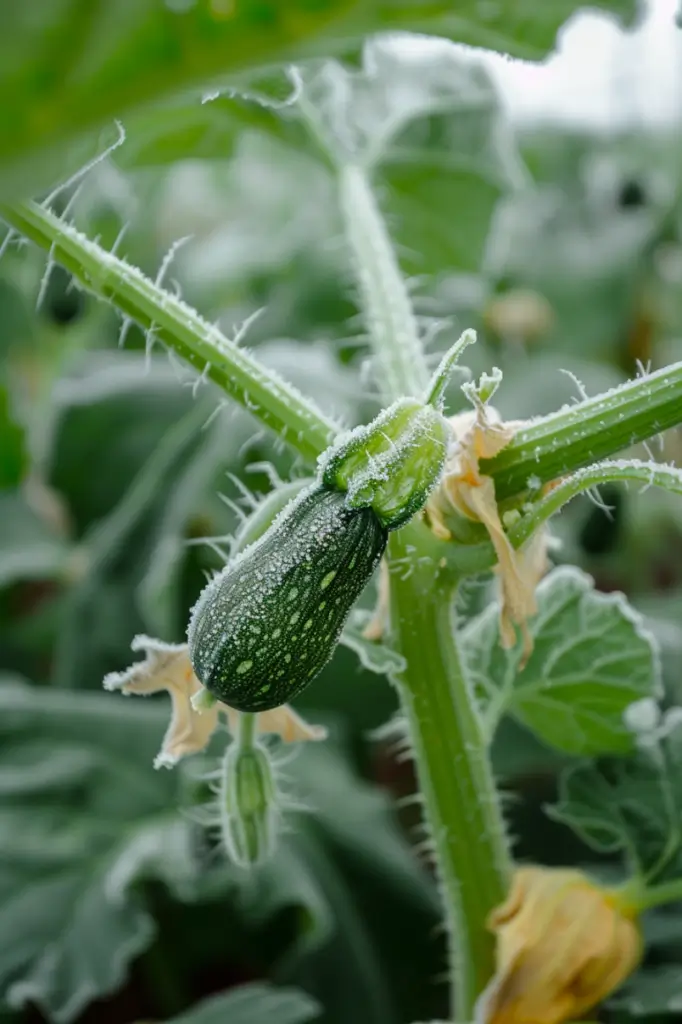
- Read also: A Guide to Eradication: Squash Bugs on Zucchini Plants
- Read also: A Comprehensive Guide: How to Harvest Your Zucchini Plants
Conclusion
Powdery mildew can be a challenging problem for zucchini growers, but with the right knowledge and preventive measures, you can keep your plants healthy and productive.
By understanding the causes, recognizing the symptoms early, and employing organic treatment methods, you can effectively manage powdery mildew in your garden.

